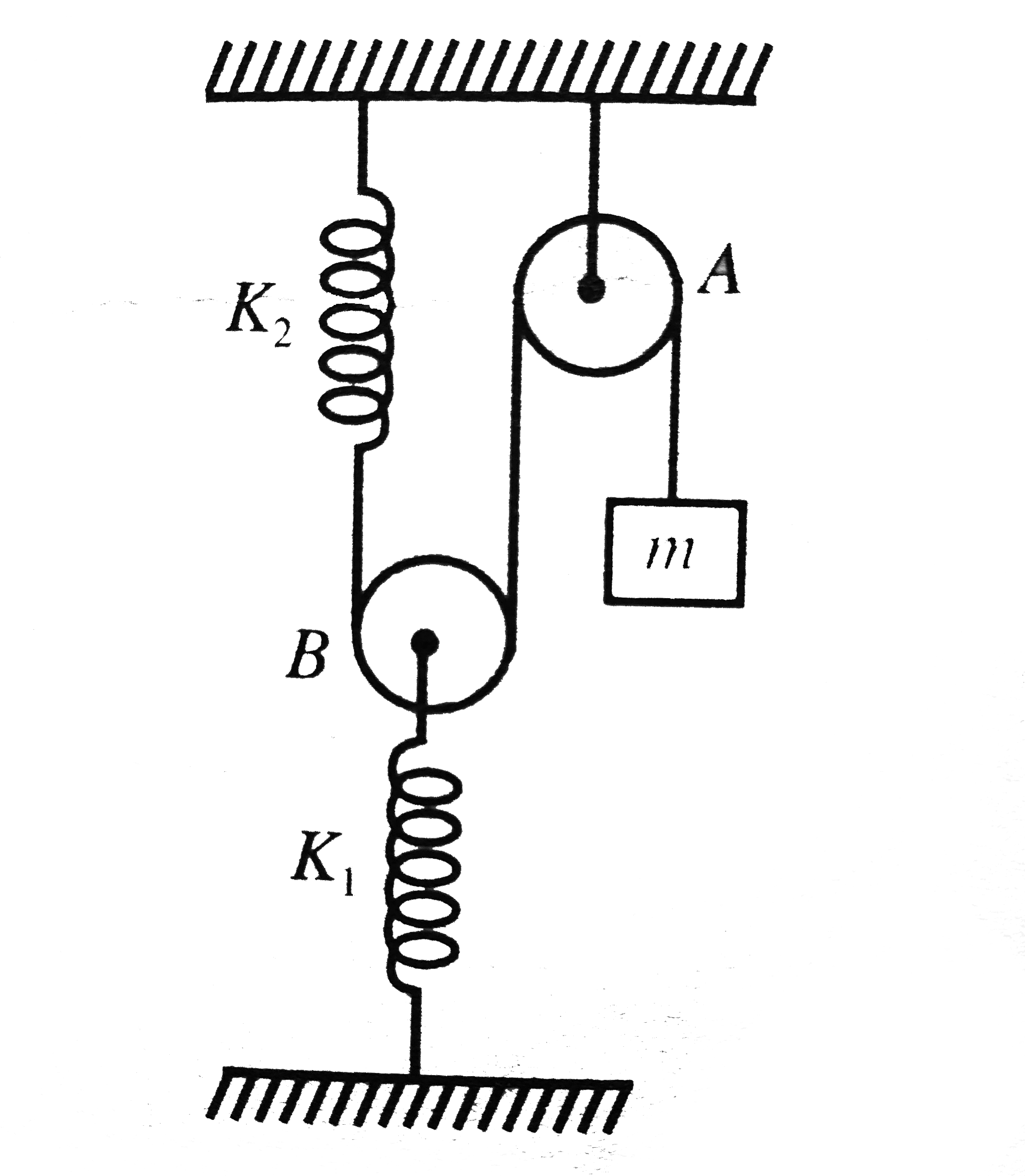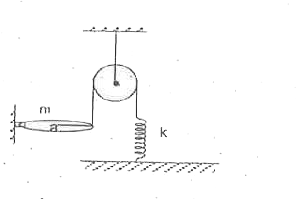A light body is hanging at the lower end of a vertical spring . On passing current in the spring, the body
(a)rises up
(b)goes down
(c)no change
(d)oscillates up & down
The correct Answer is:1
To solve the problem step by step, we can analyze the situation involving the light body hanging from a vertical spring when current is passed through the spring.
1. Understanding the Setup:
- We have a vertical spring with a light body (let's denote its weight as W) hanging from its lower end.
- The spring is fixed at its upper end, and the body is suspended at the lower end.
Hint: Visualize the setup by drawing a vertical spring with a mass hanging from it.
2. Current Flow:
- When current is passed through the spring, we can consider the spring as a coil that carries current.
- The direction of the current flow is important to determine the magnetic effects.
Hint: Remember that current creates a magnetic field around the conductor.
3. Magnetic Interaction:
- According to the right-hand rule, when current flows through a conductor, it generates a magnetic field.
- In this case, the magnetic field produced by the current in the spring will interact with the magnetic field of the earth (or any nearby magnetic field).
Hint: Think about how magnetic fields interact with each other.
4. Force on the Body:
- The magnetic field generated by the current will exert a force on the light body hanging from the spring.
- This force will act in such a way that it attracts the body upwards.
Hint: Consider the direction of the force due to the magnetic field and how it affects the weight of the body.
5. Effect on Spring Extension:
- As the magnetic force acts on the body, it will counteract the weight of the body.
- This results in a decrease in the extension of the spring, as the body is lifted upwards.
Hint: Relate the decrease in extension to the balance of forces acting on the body.
6. Conclusion:
- Since the magnetic force is acting upwards, the body will rise as the extension of the spring decreases.
- Therefore, we conclude that the body will move upward when the current is passed through the spring.
Hint: Summarize the effects of the magnetic force and the spring's response to the current.
Final Answer:
The body will rise up when current is passed through the spring.
- We have a vertical spring with a light body (let's denote its weight as W) hanging from its lower end.
- The spring is fixed at its upper end, and the body is suspended at the lower end.
- When current is passed through the spring, we can consider the spring as a coil that carries current.
- The direction of the current flow is important to determine the magnetic effects.
- According to the right-hand rule, when current flows through a conductor, it generates a magnetic field.
- In this case, the magnetic field produced by the current in the spring will interact with the magnetic field of the earth (or any nearby magnetic field).
- The magnetic field generated by the current will exert a force on the light body hanging from the spring.
- This force will act in such a way that it attracts the body upwards.
- As the magnetic force acts on the body, it will counteract the weight of the body.
- This results in a decrease in the extension of the spring, as the body is lifted upwards.
- Since the magnetic force is acting upwards, the body will rise as the extension of the spring decreases.
- Therefore, we conclude that the body will move upward when the current is passed through the spring.
The body will rise up when current is passed through the spring.
Topper's Solved these Questions
- MOVING CHARGES & MAGNETISM BOOK - VMC MODULES ENGLISHCHAPTER - MOVING CHARGES & MAGNETISM EXERCISE - PRACTICE EXERCISE 8
5 Videos
- MOVING CHARGES & MAGNETISM BOOK - VMC MODULES ENGLISHCHAPTER - MOVING CHARGES & MAGNETISM EXERCISE - PRACTICE EXERCISE 9
5 Videos
- MOVING CHARGES & MAGNETISM BOOK - VMC MODULES ENGLISHCHAPTER - MOVING CHARGES & MAGNETISM EXERCISE - PRACTICE EXERCISE 6
5 Videos
- Motion in Two DimensionsBOOK - VMC MODULES ENGLISHCHAPTER - Motion in Two DimensionsEXERCISE - MCQ
2 Videos
- PROPERTIES OF MATTERBOOK - VMC MODULES ENGLISHCHAPTER - PROPERTIES OF MATTEREXERCISE - JEE Advanced (Archive) Level - 2 (MATRIX MATCH TYPE)
1 Videos
Similar Questions
A light pulley is suspended at the lower end of a spring of constant k1, as shown in figure. An inextensible string passes over the pulley. At one end of string a mass m is suspended, the other end of the string is attached to another spring of constant k2. The other ends of both the springs are attached to rigid supports, as shown. Neglecting masses of springs and any friction, find the time period of small oscillations of mass m about equilibrium position.

View SolutionA 50g mass hangs at the end of a massless spring. When 20g more are added to the end of the spring, it stretches 7.0cm more. (a) Find the spring constant. (b) If the 20g are now removed, what will be the period of the motion ?
View Solution
Knowledge Check
When a body is suspended from two light springs separately, the periods of vertical oscillations are T1 and T2. When the same body is suspended from the two spring connected in series, the period will be
AT=T1+T2B1T=1T1+1T2CT2=T21+T22D1T2=1T21+1T2
A ball of mass m is attached to the lower end of a light vertical spring of force constant K. The upper end of the spring is fixed. The ball is released from rest with the spring at its normal ( unstretched ) length, and comed to rest again after descending through a distance x.
View Solution
A block of mass m is tied to one end of a spring which passes over a smooth fixed pulley A and under a light smooth movable pulley B. The other end of the string is attached to the lower end of a spring of spring constant K2. Find the period of small oscillation of mass m about its equilibrium position (in second). (Take m=π2kg,K2k=4K1,K1=17Nm.)
View SolutionWhen a 20 g mass hangs attached to one end of a light spring of length 10 cm, the spring stretches by 2 cm. The mass is pulled down until the total length of the spring is 14 cm. The elastic energy, (in Joule) stored in the spring is :
View SolutionA ring of mass m and radius a is connected to an inextensible string which passes over a frictionless pulley. The other end of string is connected to upper end of a massless spring of spring constant k. The lower end of the spring is fixed. The ring can rotate in the vertical plane about hinge without any friction. If horizontal position of ring is equilibrium position then find time period of small in oscillations of the ring.

View SolutionA spring has natural length 40cm and spring constant 500N/m. A block of mass 1kg is attached at one end of the spring and other end of the spring is attached to a ceiling. The block is relesed from the position, where the spring has length 45cm.
View SolutionA block of mass m attached in the lower and vertical spring The spring is hung from a calling and force constant value k The mass is released from rest with the spring initially unstreched The maximum value of extension produced in the length of the spring will be
View SolutionA vertical spring with force constant k is fixed on a table. A ball of mass m at a height h above the free upper end of the spring falls vertically on the spring , so that the spring is compressed by a distance d. The net work done in the process is
View Solution
